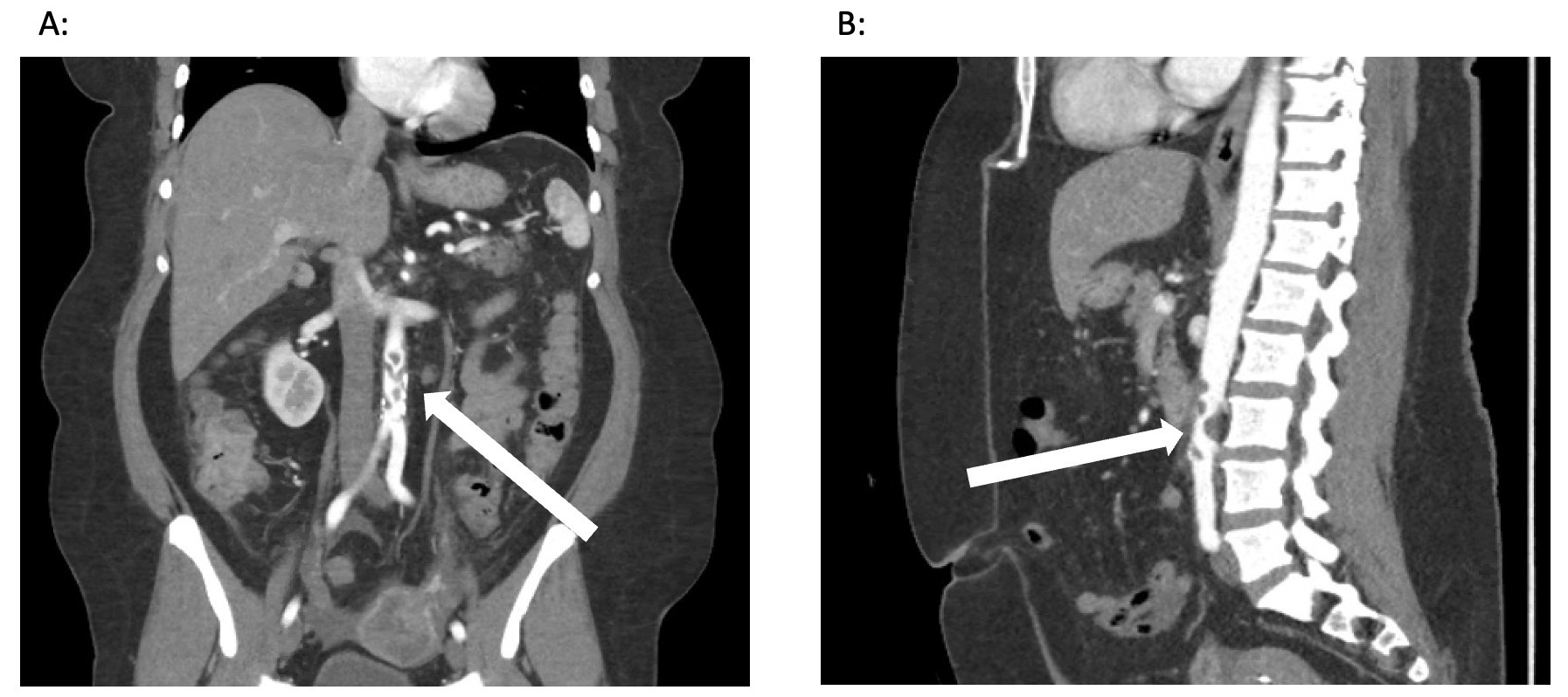Back
Poster Session E - Tuesday Afternoon
E0160 - Colon Cancer Presenting as an Aortic Thrombus, Common Things Can Present Uncommonly
Tuesday, October 25, 2022
3:00 PM – 5:00 PM ET
Location: Crown Ballroom

Shaharyar Zuberi, MD
Beth Israel Deaconess Medical Center, Harvard Medical School
Boston, MA
Presenting Author(s)
Shaharyar Zuberi, MD1, John Birk, MD2, Steven A. Goldenberg, MD2
1Beth Israel Deaconess Medical Center, Harvard Medical School, Boston, MA; 2UConn Health, Farmington, CT
Introduction: Aortic thrombosis is a rare complication of malignancy in the absence of other aortic disease. While venous thrombosis has a well-established association with cancer, arterial thrombosis has not been reported as extensively. We present a case of aortic thrombosis in a patient who was found to have stage 4 adenocarcinoma of the colon.
Case Description/Methods: A 47-year old female with a past medical history significant for hypothyroidism and DVT secondary to leg fracture presented with sudden onset sharp epigastric abdominal pain and numbness in both legs. Labs were significant for iron deficiency anemia and physical exam was significant for tenderness to palpation in the periumbilical area and right toe cyanosis. Computed tomography angiography (CTA) of the abdomen/pelvis revealed intraluminal thrombi at the distal thoracic aortic arch and the distal abdominal aorta proximal to the bifurcation. She was admitted and started on intravenous heparin, bridged to warfarin, and discharged on hospital day 3.
During outpatient follow-up, a transvaginal ultrasound was performed which revealed a 10cm left adnexal mass. She had an elevated CEA with normal CA-125. Due to iron deficiency anemia, a colonoscopy was performed which revealed an 8.5cm fungating and ulcerated mass in the proximal ascending colon with biopsy positive for adenocarcinoma. Patient underwent a right colectomy, small bowel resection, salpingo-oophorectomy, and an omentectomy. The ovarian mass pathology was consistent with adenocarcinoma of the colon. A diagnosis of stage 4 colon adenocarcinoma was made and she was started on FOLFOX chemotherapy.
Discussion: Aortic thrombosis is a rare phenomenon in the absence of aneurysmal disease, dissection, or severe atherosclerosis. While malignancy is a well-studied risk factor for venous thromboembolism, data on its risk for aortic thrombosis is limited. One study indicated that 11.5% of patients with arterial thrombosis had an associated malignancy while another indicated that malignancy increases the risk of arterial thrombosis from 2.2% to 4.7%. Although the pathogenesis remains unclear, mechanisms proposed include the release of thrombin and vascular endothelial growth factor from cancer cells.
In terms of management, a simple anticoagulation regime has been showed to be as effective as surgical intervention. A follow-up CT scan is recommended to evaluate for thrombus resolution. In summary, an evaluation for malignancy is recommended in patients presenting with aortic thrombus.

Disclosures:
Shaharyar Zuberi, MD1, John Birk, MD2, Steven A. Goldenberg, MD2. E0160 - Colon Cancer Presenting as an Aortic Thrombus, Common Things Can Present Uncommonly, ACG 2022 Annual Scientific Meeting Abstracts. Charlotte, NC: American College of Gastroenterology.
1Beth Israel Deaconess Medical Center, Harvard Medical School, Boston, MA; 2UConn Health, Farmington, CT
Introduction: Aortic thrombosis is a rare complication of malignancy in the absence of other aortic disease. While venous thrombosis has a well-established association with cancer, arterial thrombosis has not been reported as extensively. We present a case of aortic thrombosis in a patient who was found to have stage 4 adenocarcinoma of the colon.
Case Description/Methods: A 47-year old female with a past medical history significant for hypothyroidism and DVT secondary to leg fracture presented with sudden onset sharp epigastric abdominal pain and numbness in both legs. Labs were significant for iron deficiency anemia and physical exam was significant for tenderness to palpation in the periumbilical area and right toe cyanosis. Computed tomography angiography (CTA) of the abdomen/pelvis revealed intraluminal thrombi at the distal thoracic aortic arch and the distal abdominal aorta proximal to the bifurcation. She was admitted and started on intravenous heparin, bridged to warfarin, and discharged on hospital day 3.
During outpatient follow-up, a transvaginal ultrasound was performed which revealed a 10cm left adnexal mass. She had an elevated CEA with normal CA-125. Due to iron deficiency anemia, a colonoscopy was performed which revealed an 8.5cm fungating and ulcerated mass in the proximal ascending colon with biopsy positive for adenocarcinoma. Patient underwent a right colectomy, small bowel resection, salpingo-oophorectomy, and an omentectomy. The ovarian mass pathology was consistent with adenocarcinoma of the colon. A diagnosis of stage 4 colon adenocarcinoma was made and she was started on FOLFOX chemotherapy.
Discussion: Aortic thrombosis is a rare phenomenon in the absence of aneurysmal disease, dissection, or severe atherosclerosis. While malignancy is a well-studied risk factor for venous thromboembolism, data on its risk for aortic thrombosis is limited. One study indicated that 11.5% of patients with arterial thrombosis had an associated malignancy while another indicated that malignancy increases the risk of arterial thrombosis from 2.2% to 4.7%. Although the pathogenesis remains unclear, mechanisms proposed include the release of thrombin and vascular endothelial growth factor from cancer cells.
In terms of management, a simple anticoagulation regime has been showed to be as effective as surgical intervention. A follow-up CT scan is recommended to evaluate for thrombus resolution. In summary, an evaluation for malignancy is recommended in patients presenting with aortic thrombus.

Figure: Coronal (A) and sagittal (B) views of CTA abdomen/pelvis. Arrows pointing to intraluminal thrombi in the distal abdominal aorta just proximal to the aortic bifurcation
Disclosures:
Shaharyar Zuberi indicated no relevant financial relationships.
John Birk indicated no relevant financial relationships.
Steven Goldenberg indicated no relevant financial relationships.
Shaharyar Zuberi, MD1, John Birk, MD2, Steven A. Goldenberg, MD2. E0160 - Colon Cancer Presenting as an Aortic Thrombus, Common Things Can Present Uncommonly, ACG 2022 Annual Scientific Meeting Abstracts. Charlotte, NC: American College of Gastroenterology.
